Effect of Carbon Nanotube and Styrene-Acrylic Emulsion Additives on Microstructure and Mechanical Characteristics of Cement Paste
Abstract
1. Introduction
2. Materials and Methods
2.1. Materials
2.2. Sample Preparation and Mix Design
2.3. Testing Methods
3. Results and Discussion
3.1. Carbon Nanotube-Raman Spectra and Transmission Electron Microscopy
3.2. Mechanical Properties of Cement Composites
3.3. Capillary Water Absorption of the Cement Composites
3.4. Porosity and Pore Size Distribution of Cement Pastes
3.5. FTIR Patterns of the Cement Pastes
3.6. Scanning Electron Micrographs of the Cement Pastes
4. Conclusions
- i.
- The mechanical properties of the cement composites show that the combined use of 0.1 wt.% CNT–OH and 15 wt.% SAE in the cement matrix can increase the flexural strength by approximately 45% at 28 days and was obviously higher than that of the addition of CNT–OH or SAE alone.
- ii.
- The capillary water absorption test results show that the simultaneous incorporation of CNTs and SAE latex can significantly improve the water permeability resistance of cement paste. The water absorption rate (120 h) and sorptivity of HSPC were 82% and 78% lower than that of the PC, respectively.
- iii.
- The mono and hybrid additions of CNTs–OH and SAE could decrease the porosity and refine the pore structure of concrete, as demonstrated by the MIP analysis.
- iv.
- According to FTIR analyses, the addition of SAE and CNTs–OH decreased the Ca(OH)2 content of cement paste, indicating the interaction takes place among SAE, CNTs–OH and cement hydration productions.
- v.
- CNT–OH/SAE hybrid network films could be observed in cement paste by using FESEM. The crack-bridging and pore-filling effects of networks were responsible for the enhancement of the CNT–OH and SAE hybrid solution on the mechanical properties and water resistance of cement paste.
Author Contributions
Funding
Acknowledgments
Conflicts of Interest
References
- Parveen, S.; Rana, S.; Fangueiro, R. A Review on Nanomaterial Dispersion, Microstructure, and Mechanical Properties of Carbon Nanotube and Nanofiber Reinforced Cementitious Composites. J. Nanomater. 2013, 2013, 710175. [Google Scholar] [CrossRef]
- Liu, J.; Fu, J.; Ni, T.; Yang, Y. Fracture toughness improvement of multi-wall carbon nanotubes/graphene sheets reinforced cement paste. Constr. Build. Mater. 2019, 200, 530–538. [Google Scholar] [CrossRef]
- Tang, S.; Yao, Y.; Andrade, C.; Li, Z. Recent durability studies on concrete structure. Cem. Concr. Res. 2015, 78, 143–154. [Google Scholar] [CrossRef]
- Shah, S.P.; Konsta-Gdoutos, M.S.; Metaxa, Z.S. Highly-dispersed carbon nanotube-reinforced cement-based materials. Cem. Concr. Res. 2010, 40, 1052–1059. [Google Scholar]
- Mendoza Reales, O.A.; Toledo Filho, R.D. A review on the chemical, mechanical and microstructural characterization of carbon nanotubes-cement based composites. Constr. Build. Mater. 2017, 154, 697–710. [Google Scholar] [CrossRef]
- Han, B.; Sun, S.; Ding, S.; Zhang, L.; Yu, X.; Ou, J. Review of nanocarbon-engineered multifunctional cementitious composites. Compos. Part A Appl. Sci. Manuf. 2015, 70, 69–81. [Google Scholar] [CrossRef]
- Hu, Y.; Luo, D.; Li, P.; Li, Q.; Sun, G. Fracture toughness enhancement of cement paste with multiwalled carbon nanotubes. Constr. Build. Mater. 2014, 70, 332–338. [Google Scholar] [CrossRef]
- María, D.C.C.; Galao, O.; Baeza, F.; Emilio, Z. Mechanical Properties and Durability of CNT. Cem. Compos. Mater. 2014, 7, 1640–1651. [Google Scholar]
- Hogancamp, J.; Grasley, Z. The use of microfine cement to enhance the efficacy of carbon nanofibers with respect to drying shrinkage crack resistance of portland cement mortars. Cem. Compos. Mater. 2017, 83, 405–414. [Google Scholar] [CrossRef]
- Konsta-Gdoutos, M.S.; Batis, G.; Danoglidis, P.A.; Zacharopoulou, A.K.; Zacharopoulou, E.K.; Falara, M.G.; Shah, S.P. Effect of CNT and CNF loading and count on the corrosion resistance, conductivity and mechanical properties of nanomodified OPC mortars. Constr. Build. Mater. 2017, 147, 48–57. [Google Scholar] [CrossRef]
- Li, W.; Ji, W.; Wang, Y.; Liu, Y.; Shen, R.X.; Xing, F. Investigation on the Mechanical Properties of a Cement-Based Material Containing Carbon Nanotube under Drying and Freeze-Thaw Conditions. Materials 2015, 8, 8780–8792. [Google Scholar] [CrossRef] [PubMed]
- Sanchez, F.; Ince, C. Microstructure and macroscopic properties of hybrid carbon nanofiber/silica fume cement composites. Compos. Sci. Technol. 2009, 69, 1310–1318. [Google Scholar] [CrossRef]
- Collins, F.; Lambert, J.; Duan, W.H. The influences of admixtures on the dispersion, workability, and strength of carbon nanotube- OPC paste mixtures. Cem. Compos. Mater. 2012, 34, 201–207. [Google Scholar] [CrossRef]
- Spitalsky, Z.; Tasis, D.; Papagelis, K.; Galiotis, C. Carbon nanotube-polymer composites: Chemistry, processing, mechanical and electrical properties. Prog. Polym. Sci. 2010, 35, 357–401. [Google Scholar] [CrossRef]
- Chakraborty, S.; Kundu, S.P.; Roy, A.; Adhikari, B.; Majumder, S.B. Polymer modified jute fibre as reinforcing agent controlling the physical and mechanical characteristics of cement mortar. Constr. Build. Mater. 2013, 49, 214–222. [Google Scholar] [CrossRef]
- Baueregger, S.; Perello, M.; Plank, J. Influence of carboxylated styrene-butadiene latex copolymer on Portland cement hydration. Cem. Compos. Mater. 2015, 63, 42–50. [Google Scholar] [CrossRef]
- Almeida, A.E.; Sichieri, E.P. Mineralogical study of polymer modified mortar with silica fume. Constr. Build. Mater. 2006, 20, 882–887. [Google Scholar] [CrossRef]
- Shaker, F.A.; El-Dieb, A.S.; Reda, M.M. Durability of Styrene-Butadiene latex modified concrete. Cem. Concr. Res. 1997, 27, 711–720. [Google Scholar] [CrossRef]
- Peddini, S.K.; Bosnyak, C.P.; Henderson, N.M.; Ellison, C.; Paul, D.R. Nanocomposites from styrene-butadiene rubber (SBR) and multiwall carbon nanotubes (MWCNT) part 1: Morphology and rheology. Polymer 2014, 55, 258–270. [Google Scholar] [CrossRef]
- Vedala, H.; Huang, J.; Zhou, X.Y.; Kim, G.; Roy, S.; Choi, W.B. Effect of PVA functionalization on hydrophilicity of Y-junction mono wall carbon nanotubes. Appl. Surf. Sci. 2006, 252, 7987–7992. [Google Scholar] [CrossRef]
- Li, L.; Wang, R.; Lu, Q. Influence of polymer latex on the setting time, mechanical properties and durability of calcium sulfoaluminate cement mortar. Constr. Build. Mater. 2018, 169, 911–922. [Google Scholar] [CrossRef]
- Young-Kug, J. Adhesion in tension of polymer cement mortar by curing conditions using polymer dispersions as cement modifier. Constr. Build. Mater. 2020, 242, 118134. [Google Scholar]
- Cao, J.; Chung, D.D.L. Carbon fiber reinforced cement mortar improved by using acrylic dispersion as an admixture. Cem. Concr. Res. 2001, 31, 1633–1637. [Google Scholar] [CrossRef]
- NSAI. Method of Testing Cements-Determination of Strength: GB/T 17671–1999; Architecture and Building Press: Beijing, China, 2003. (In Chinese) [Google Scholar]
- DIN. Determination of the Water Absorption Coefficient of Construction Materials: DIN 52617; Deutsches Institut fur Nor-mung Press: Berlin, Germany, 1987. [Google Scholar]
- Bokobza, L.; Bruneel, J.L.; Couzi, M. Raman spectroscopic investigation of carbon-based materials and their composites. Comparison between carbon nanotubes and carbon black. Chem. Phys. Lett. 2013, 590, 153–159. [Google Scholar] [CrossRef]
- Lopez-Lorente, A.I.; Simonet, B.M.; Valcarcel, M.; Mizaikoff, B. Bare gold nanoparticles mediated surface-enhanced Raman spectroscopic determination and quantification of carboxylated mono-walled carbon nanotubes. Anal. Chim. Acta 2013, 788, 122–128. [Google Scholar] [CrossRef]
- Wood, J.R.; Zhao, Q.; Wagner, H.D. Orientation of carbon nanotubes in polymers and its detection by Raman spectroscopy. Compos. Part A Appl. Sci. Manuf. 2001, 32, 391–399. [Google Scholar] [CrossRef]
- Yan, X.; Kitahama, Y.; Sato, H.; Suzuki, T.; Han, X.; Itoh, T.; Bokobza, L.; Ozaki, Y. Laser heating effect on Raman spectra of styrene-butadiene rubber/multiwalled carbon nanotube nanocomposites. Chem. Phys. Lett. 2012, 523, 87–91. [Google Scholar] [CrossRef]
- Wang, S.; Liang, R.; Wang, B.; Zhang, C. Load-transfer in functionalized carbon nanotubes/polymer composites. Chem. Phys. Lett. 2008, 457, 371–375. [Google Scholar] [CrossRef]
- Bokobza, L.; Bruneel, J.L.; Couzi, M. Raman spectroscopy as a tool for the analysis of carbon-based materials (highly oriented pyrolitic graphite, multilayer graphene and multiwall carbon nanotubes) and of some of their elastomeric composites. Vib. Spectrosc. 2014, 74, 57–63. [Google Scholar] [CrossRef]
- Xu, S.; Liu, J.; Li, Q. Mechanical properties and microstructure of multi-walled carbon nanotube-reinforced cement paste. Constr. Build. Mater. 2015, 76, 16–23. [Google Scholar] [CrossRef]
- Eren, F.; Godek, E.; Keskinates, M.; Tosun-Felekoğlu, K.; Felekoğlu, B. Effects of latex modification on fresh state consistency, short term strength and long term transport properties of cement mortars. Constr. Build. Mater. 2017, 133, 226–233. [Google Scholar] [CrossRef]
- Torabian Isfahani, F.; Li, W.; Redaelli, E. Dispersion of multi-walled carbon nanotubes and its effects on the properties of cement composites. Cem. Compos. Mater. 2016, 74, 154–163. [Google Scholar] [CrossRef]
- Stobinski, L.; Lesiak, B.; Kovér, L.; Toth, J.; Biniak, S.; Trykowski, G.; Judek, J. Multiwall carbon nanotubes purification and oxidation by nitric acid studied by the FTIR and electron spectroscopy methods. J. Alloy Compd. 2010, 501, 77–84. [Google Scholar] [CrossRef]
- Wang, R.; Yao, L.; Wang, P. Mechanism analysis and effect of styrene-acrylate copolymer powder on cement hydrates. Constr. Build. Mater. 2013, 41, 538–544. [Google Scholar] [CrossRef]
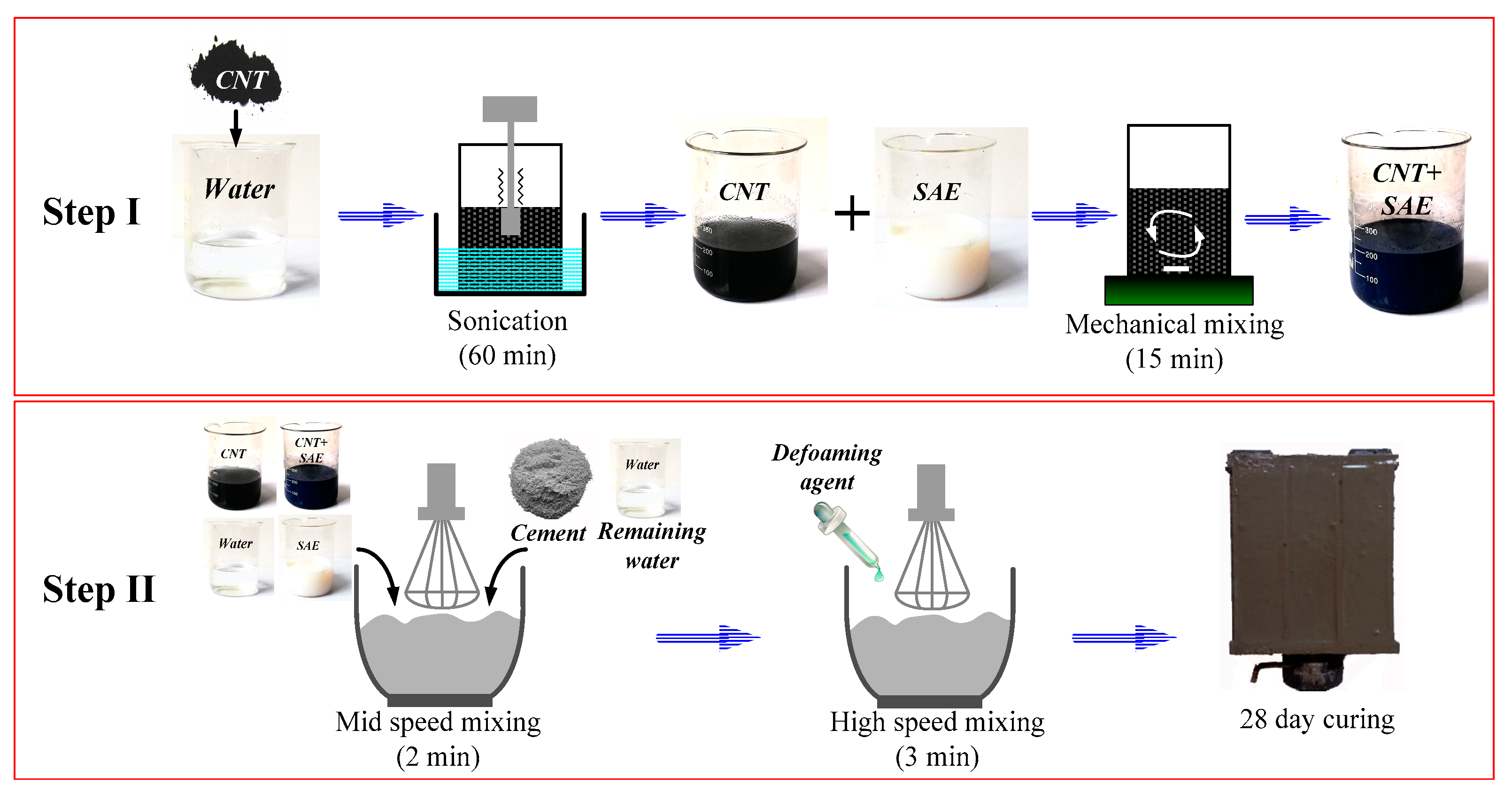

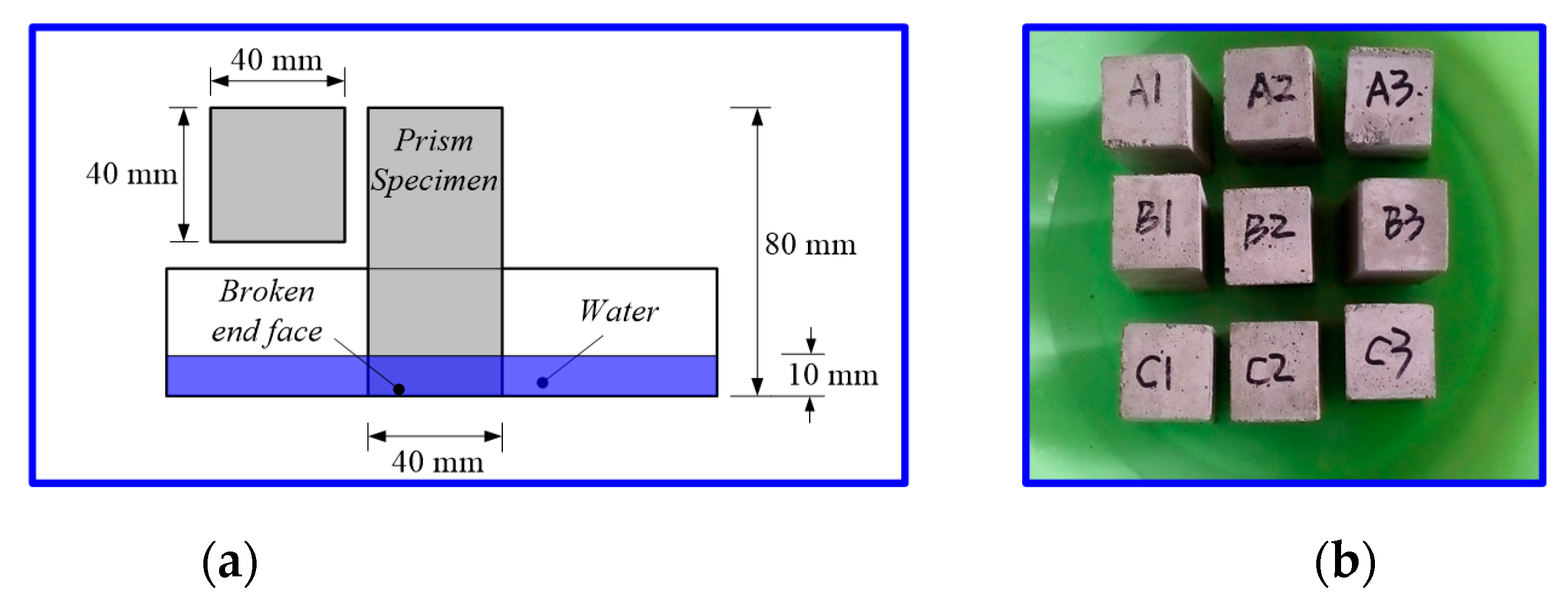
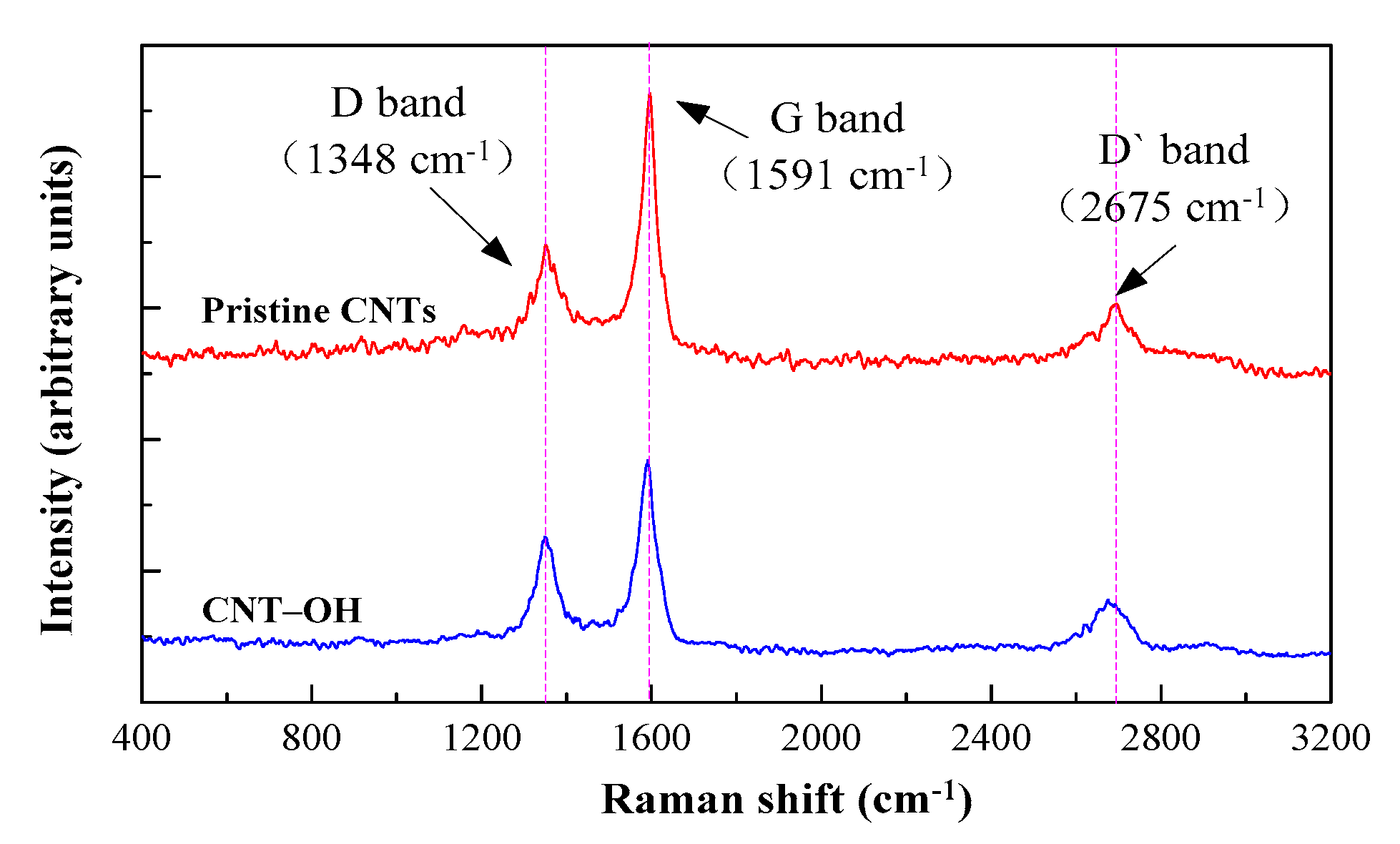

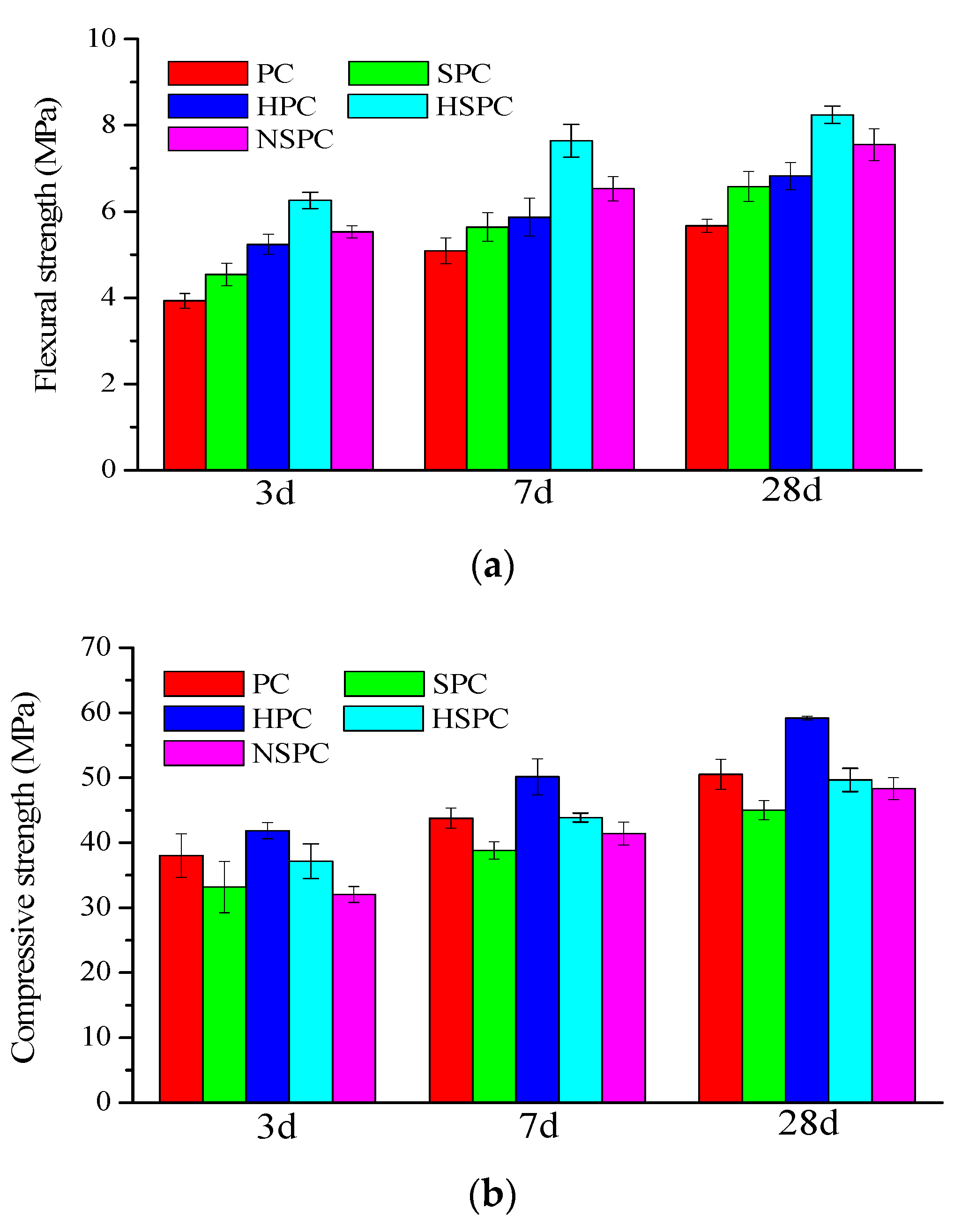
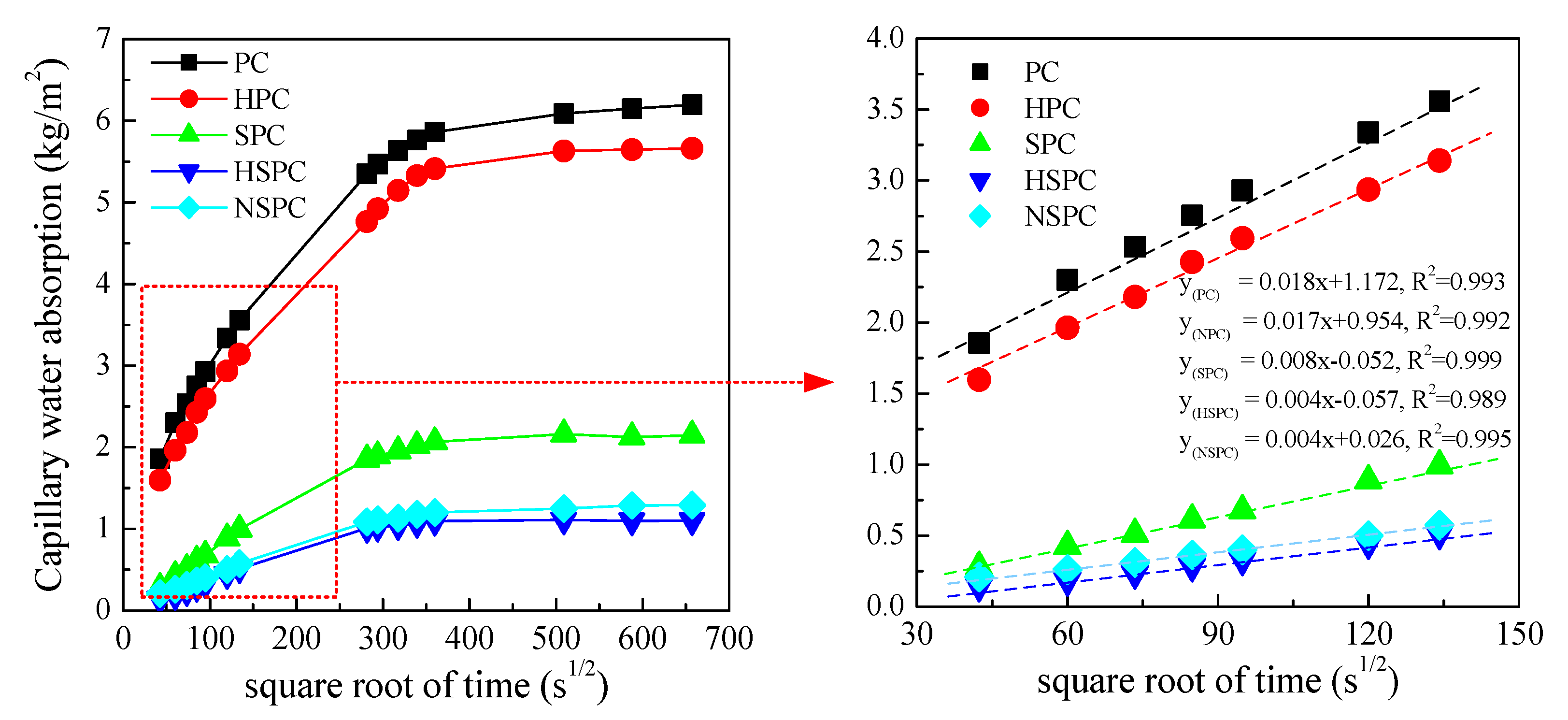
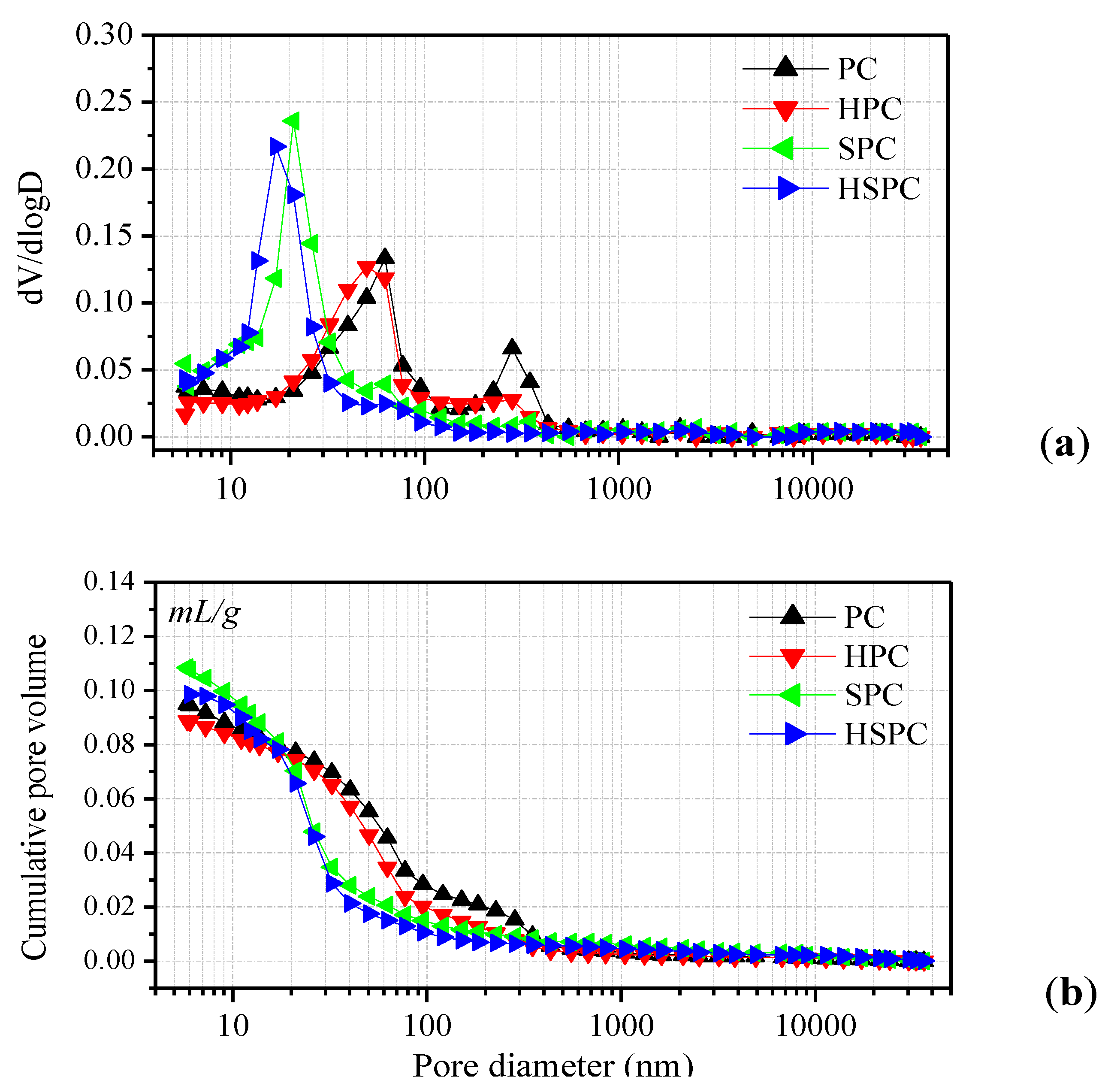
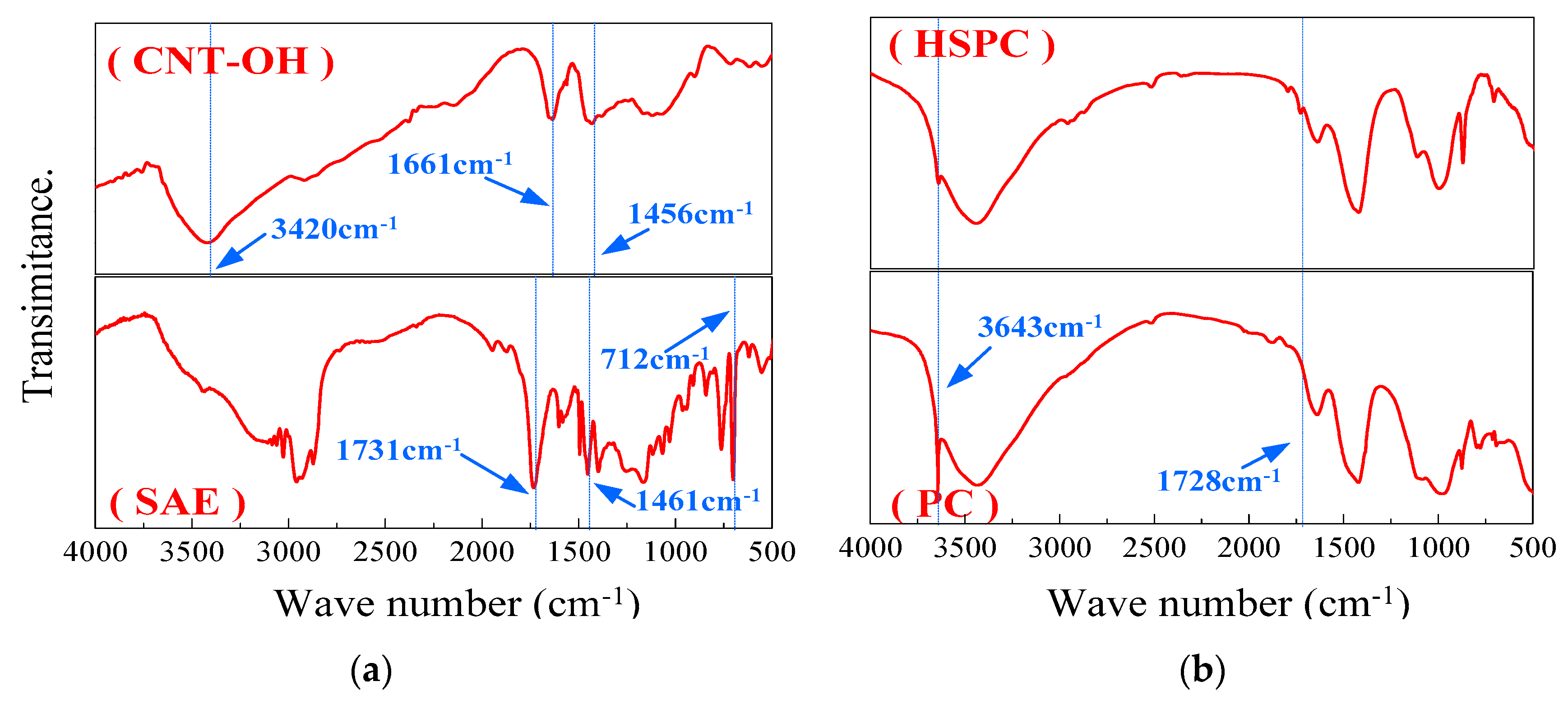

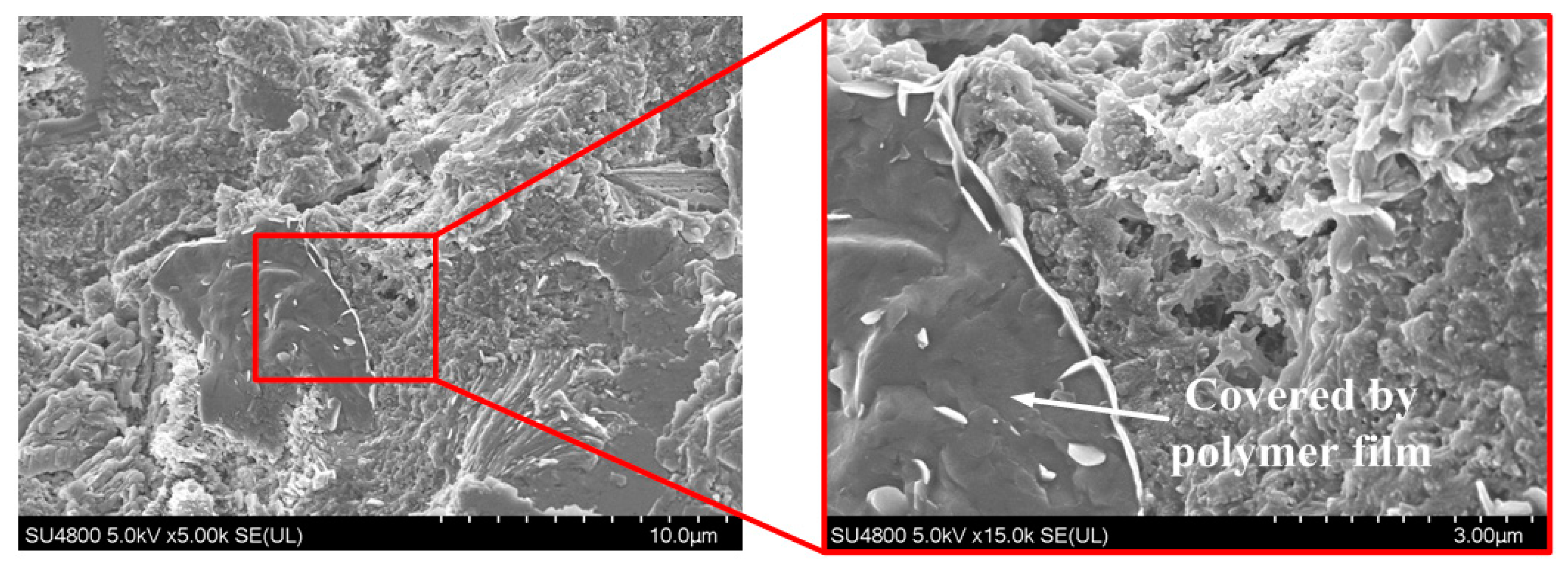
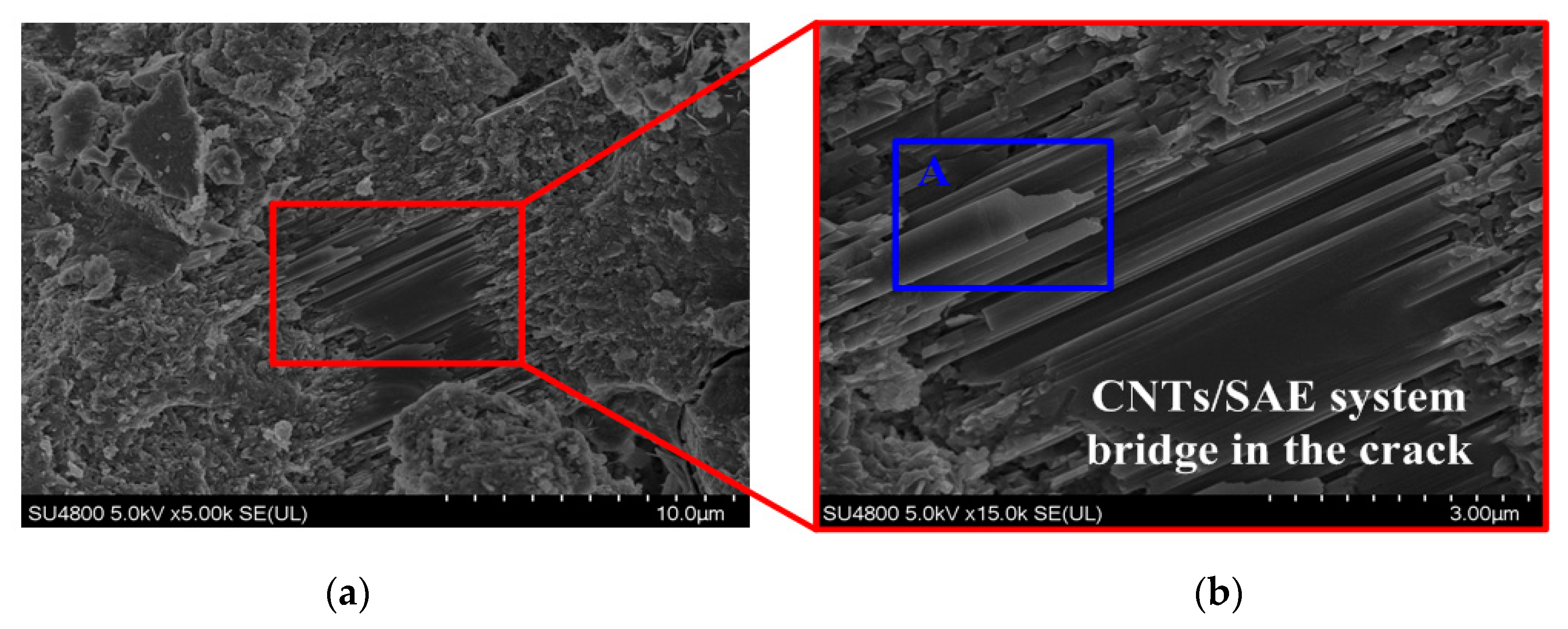
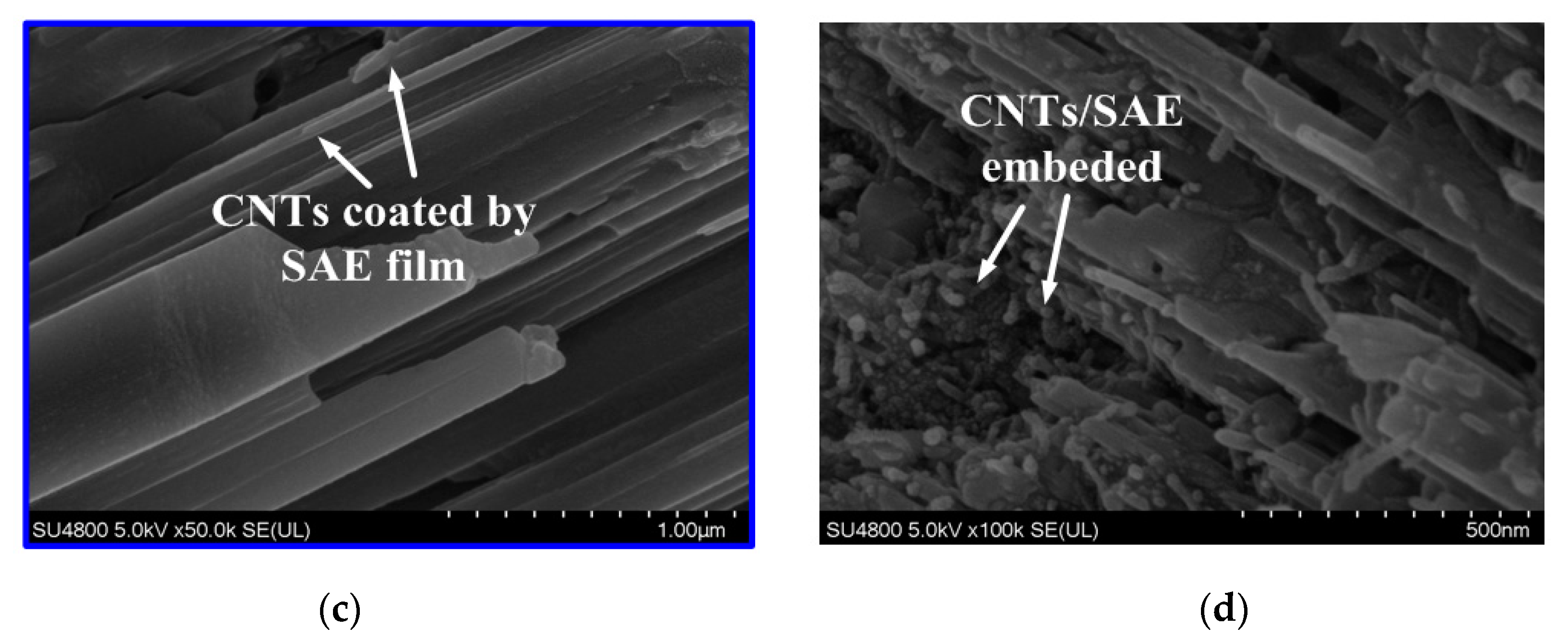
| P. O 42.5 R | Raw Material (%) | ||||||||
| SiO2 | Al2O3 | CaO | MgO | Na2O | K2O | Fe2O3 | SO3 | Loss on ignition | |
| 18.3 | 4.5 | 62.4 | 2.1 | 0.3 | 1.5 | 2.3 | 3.5 | 2.6 | |
| SAE Latex | Solid Content | Tg | Viscosity | pH | Minimum Film Forming Temperature | Appearance |
| 48 ± 1 (wt.%) | 23 (°C) | 500–2000 (mPa·s) | 7~9 | 21 (°C) | Milky white liquid |
| Raw Material | External Diameter (nm) | Purity (wt.%) | Length (μm) | Specific Surface Area (m2/g) | ASH (wt%) | Tap Density (g/cm3) | –OH Content (%) |
|---|---|---|---|---|---|---|---|
| CNT | 10~30 | 95 | 10~30 | >110 | <5 | 0.14 | – |
| CNT–OH | 10~30 | 95 | 10~30 | >110 | <5 | 0.14 | 2.48 |
| Samples ID | Ratio of Material Mass to Cement Mass (%) | mw/mc | Flow/mm | ||||
|---|---|---|---|---|---|---|---|
| Cement | Water | CNT | SAE | Defoamer | |||
| PC | 100 | 40 | 0 | 0 | 0.14 | 0.4 | 178 |
| HPC | 100 | 40.04 | 0.1 (CNTs–OH) | 0 | 0.14 | 0.4 | 176 |
| SPC | 100 | 32 | 0 | 15 | 0.14 | 0.32 | 182 |
| NSPC | 100 | 32.03 | 0.1 (CNTs) | 15 | 0.14 | 0.32 | 179 |
| HSPC | 100 | 32.03 | 0.1 (CNTs–OH) | 15 | 0.14 | 0.32 | 181 |
| Samples ID | Total Intruded Volume (mL/g) | Total Porosity (%) | Average Pore Diameter (nm) |
|---|---|---|---|
| PC | 0.0950 | 16.64 | 60 |
| HPC | 0.0889 | 16.30 | 52.3 |
| SPC | 0.1085 | 18.71 | 24.5 |
| HSPC | 0.0986 | 17.11 | 20.3 |
© 2020 by the authors. Licensee MDPI, Basel, Switzerland. This article is an open access article distributed under the terms and conditions of the Creative Commons Attribution (CC BY) license (http://creativecommons.org/licenses/by/4.0/).
Share and Cite
Fan, J.; Li, G.; Deng, S.; Deng, C.; Wang, Z.; Zhang, Z. Effect of Carbon Nanotube and Styrene-Acrylic Emulsion Additives on Microstructure and Mechanical Characteristics of Cement Paste. Materials 2020, 13, 2807. https://doi.org/10.3390/ma13122807
Fan J, Li G, Deng S, Deng C, Wang Z, Zhang Z. Effect of Carbon Nanotube and Styrene-Acrylic Emulsion Additives on Microstructure and Mechanical Characteristics of Cement Paste. Materials. 2020; 13(12):2807. https://doi.org/10.3390/ma13122807
Chicago/Turabian StyleFan, Jie, Gengying Li, Sijie Deng, Chengwei Deng, Zhongkun Wang, and Zhijun Zhang. 2020. "Effect of Carbon Nanotube and Styrene-Acrylic Emulsion Additives on Microstructure and Mechanical Characteristics of Cement Paste" Materials 13, no. 12: 2807. https://doi.org/10.3390/ma13122807
APA StyleFan, J., Li, G., Deng, S., Deng, C., Wang, Z., & Zhang, Z. (2020). Effect of Carbon Nanotube and Styrene-Acrylic Emulsion Additives on Microstructure and Mechanical Characteristics of Cement Paste. Materials, 13(12), 2807. https://doi.org/10.3390/ma13122807






